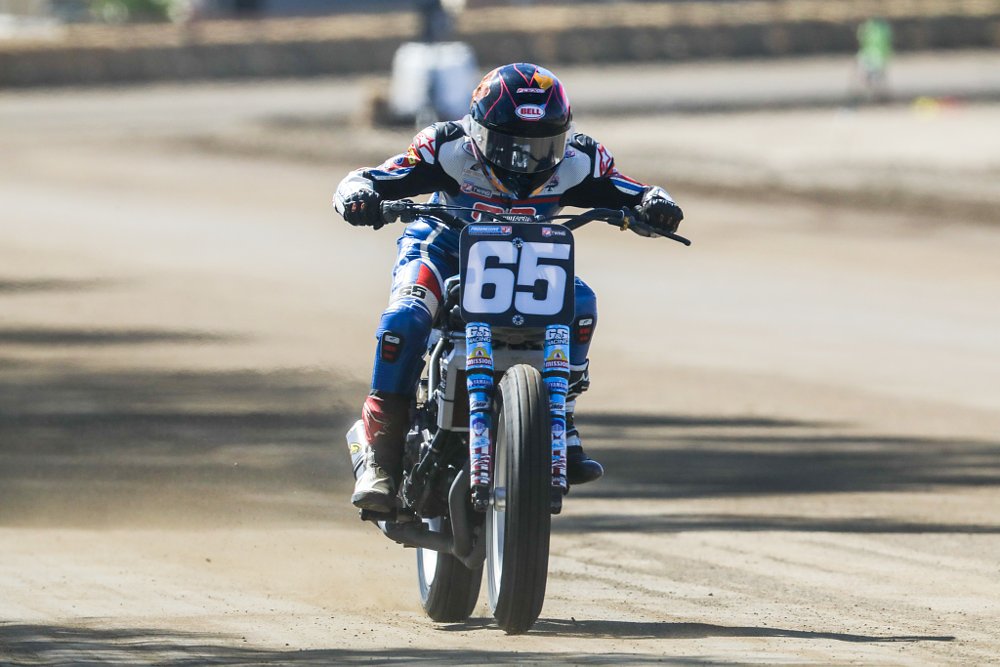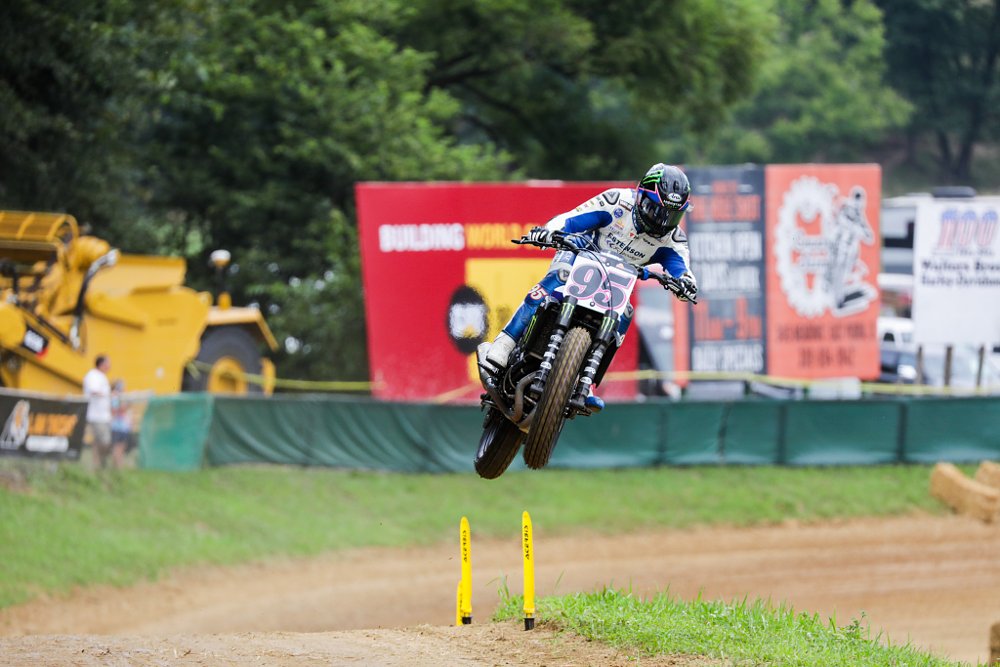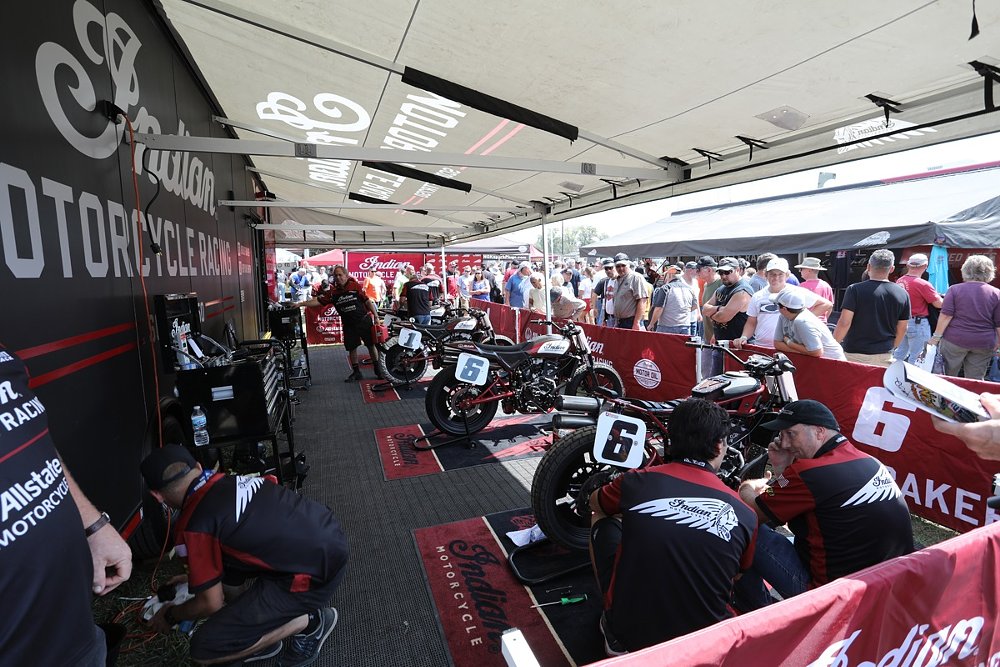American Flat Track has announced new rule changes for the 2022 season, along with a plan to consolidate the Mission SuperTwins and Production Twins classes into a single premier class beginning in 2023. While the rule changes are small in number, they are notable, and combined with the mid-year changes in 2021, we could see significant impact to the SuperTwins field.
For 2022, AFT has a transition plan that leads to the elimination of the Production Twins in 2023. For the 2022 season, the top four finishers in a Production Twins main event will get a transfer to the SuperTwins main event as part of the Mission Production Twins Challenge. Mission Foods is also sweetening the pot with $100,000 in contingency money up for grabs in the challenge.
Since AFT singles races typically take place between the Production Twins and SuperTwins main events, the riders will have some time to catch their breath and regroup for the second main. The four Production Twins riders who qualify for the SuperTwins start will be set on the Mission Production Twins Challenge Row, which is a nice way of saying the back row of the grid.
AFT is framing the transition as a "bridge" between the Production Twins class and the premier SuperTwins class. While I do like the idea and the opportunity for racers to put some more cash in their pockets, courtesy of Mission Foods, the reality is that Super Twins entries over the past few years have been dwindling to the point of not filling the grid. It seems like the AFT plan to fill out the premier class is to get rid of Production Twins.

Production Twins race bikes get advantages to be competitive
With the race-only Indian FTR750 not allowed in the Production Twins class, we're likely to see Yamahas (including the one ridden by Production Twins Champ Corey Texter), a few workhorse Kawasakis, possibly a competitive Harley-Davidson XG750, the Johnny Lewis-piloted Royal Enfield and, if my sources are correct, possibly a KTM 790 all running in the class this year and potentially advancing to a SuperTwins main. For the Production Twins racers who do advance to the premier-class main, they'll have a few rules advantages that could help them be more competitive.
Production Twins can now run 900 cc engines, giving them a 150 cc advantage over the Indian FTR750s that dominate SuperTwins. They can also use 40 mm throttle bodies as opposed to the 38 mm and 32 mm (more on this in a minute) throttle bodies in SuperTwins. Also, some of the Production Twins will have the possibility of using traction control, according to the rule book, if sensors were original equipment on the donor motorcycle. So bikes like the Yamahas and KTMs could leverage electronic control advantages.
It’s also worth noting that AFT has dropped the ridiculous and expensive "buy in" clause, which required teams to pay an additional fee amounting to thousands of dollars just to get into SuperTwins.

Rules changes in SuperTwins
AFT also made some rules changes in the SuperTwins class, and to understand where they are going, you need to understand where we've been.
The Indian FTR750 dominates SuperTwins, taking eight of the top 10 positions in the points standings in 2021. In most races, Indian FTRs make up 80 percent of the field against a few Estenson Racing Yamaha MT-07s. Harley-Davidson has seemingly given up on trying to make the XG750 competitive.
The rub is that the FTR750 isn't a production motorcycle; it was given a special exemption in 2017 that was supposed to run out in 2019 and was yet again extended. Now the issue is that banning the motorcycle would be the death of the SuperTwins class. SuperTwins has become the FTR class kind of like it was the Harley-Davidson XR750 class for the previous 30-plus years.
So AFT is now in the position of trying to level the playing field through rules changes to allow other bikes to be competitive against the purpose-built FTR750s. In the middle of the 2021 season, AFT raised the minimum weight for the FTRs to 330 pounds, from 310 pounds. They also reduced the allowable rear wheel weight and banned added flywheel weight to the FTRs during the 2021 season. In other forms of racing, adding weight to the rear wheel and flywheel assembly would be a handicap, but in flat-track racing it greatly improves the traction and controllable power delivery on corner exits on the dirt.
That brings us to the 2022 rule changes. The "race only" engines (FTR750s) will be limited to 11,500 rpm and will be restricted to 32 mm throttle body openings via an AFT-supplied restrictor plate, which is a fancy way of saying a washer in the throttle body opening. So if you are playing along at home, here’s a list of rule changes that negatively affect FTRs in the last six months: 330-pound minimum weight as opposed to 310 for the rest of the field, 35-pound max rear wheel weight as opposed to 40 pounds for the rest of the field, no added flywheel weight, 11,500 rpm max and a 32 mm throttle body restriction.
You might be thinking that the Indians were still dominant in the second half of 2021, even with the added overall weight and reduced flywheel and rear wheel weights, and you’d be correct. Plus, admittedly, the 11,500 rpm limit is only going to cost the FTR750s about 500 rpm. But the real kick in the pants is the 32 mm throttle body restriction via the restrictor plate.
Because they have to use the approved 32 mm washer, teams can't re-cast new throttle bodies or epoxy their current units into smooth, well performing, 32 mm units. According to a member of one of the top SuperTwins teams, this is going to cost them roughly 25 horsepower. That will be most apparent on mile tracks where horsepower is at a premium.

My two cents
Since taking the AFT series by storm in 2017, it's safe to say that Indian has put more time, development and money into the sport than any other manufacturer. In addition, they have paid out the most contingency dollars. According to AFT's contingency numbers, over the last three years Indian has paid out almost $1 million in contingency money. To give you an idea of how that stacks up, Yamaha was second with $80,000. Even S&S Cycles has paid out more than all the other OEMs, with $150,000 paid out.
So it seems a bit counterproductive to penalize the folks who have worked the hardest to further the sport. Instead of putting restrictions on the Indian FTR that negate years of development time and money, why not allow the other teams advantages? Instead of adding weight to the FTRs, allow reduced weight for other brands. Instead of squeezing down the Indian throttle body, why not expand the limits for the other brands, allow them more displacement or more electronic advantages? Give the other brands the opportunity to develop their bikes with advantages rather than take away what the Indian team has worked so hard to build.
And before you roll out the fact that the FTR is a "race engine" compared to the other brands' production engines, let me say this: The only thing that qualifies the other brands as "production" machines is the fact that they use stock engine cases. Everything else is light years from a production part. For instance, Harley-Davidson XG750s in AFT use a four-valve Vance & Hines head that is closer to a Suzuki Hayabusa cylinder head than a stock XG750 head.
Don’t get me wrong, I'd love to see a Super Twins grid with five or six different brands, but not at the expense of holding back the development of one team instead of encouraging the development of others.
One thing is for sure, the 2022 season is shaping up to be a banger! Bring on the Volusia season opener!

 Membership
Membership









